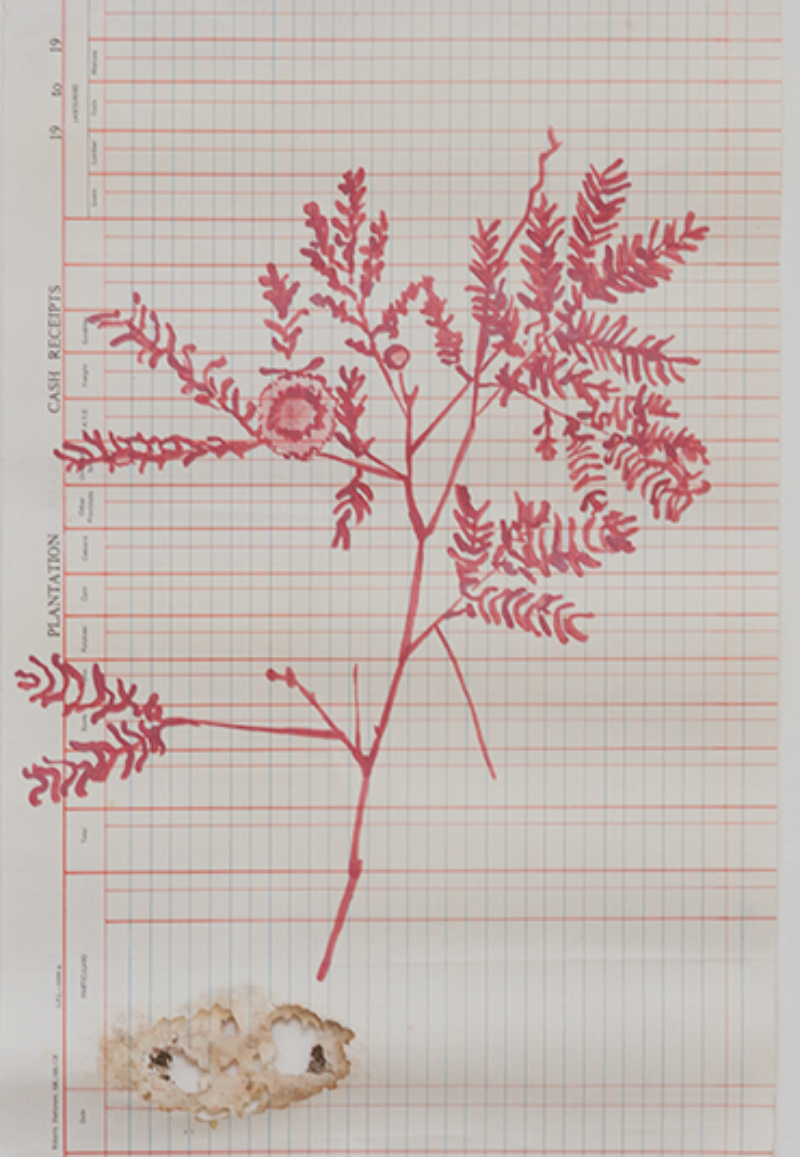Haarlem Periodical
Annalee Davis
re:wilding
Biography and history intersect in Annalee Davis’ practice which focuses on post-plantation economies. Her studio, located on a dairy farm, once a 17th-century sugar plantation, offers a critical context for her practice.
Walking the fields, finding 18th-19th-century sherds, and collecting wild botanicals, she unpacks multi-layered plantation histories. Davis’ work for Haarlem presents ledger page drawings, a commissioned sculpture responding to the 18th-century origin of the building as an industrial cotton mill, and photographic documentation of an act of remembering.
Wild Plant Series





Wild Plant Series
This series of drawings functions as graphic interventions into 1970s ledger pages, the substrate designed to log economic activity which took place on the plantation. Data entered into ledger pages comprised registering wages, field activity and rent rolls as well as measuring rainfall and the signing out of agricultural implements to plantation labourers. These drawings counter the daily logging of economic activity on the plantation by inscribing other images that offer alternate ways of reading the site. For example, wild plants can be seen to act as agents in the process of decolonising fields, performing a quiet revolution by asserting themselves against an imperial, monocrop landscape. Collecting, pressing and drawing found wild plants, complicates the single story written in these plantation ledger pages and acknowledges the medicinal properties of the plants which were once used as an apothecary by those who were enslaved and laboured on the plantation.
Sweeping the Fields



Sweeping the Fields
Sweeping the Fields is an act of remembering and of cleansing; a contemporary gesture to history’s groan which acknowledges the possibility of an emerging post-plantation apothecary. The action of sweeping, documented through a suite of photographs, developed out of my walking the fields on Walkers dairy farm in Barbados, where I live and work.
Part of a 350-year old colonial history that links the Caribbean with the rest of the world, Walkers was operational originally as a sugarcane plantation from the 1660s. It was formerly named Willoughby Plantation after the Eton-educated, English landowner and Governor of Barbados, William Willoughby, who developed the several-hundred-acre estate.
Inspired by the resurgent diversity of an emerging botanical archive asserting itself against a historically imperial landscape,
Sweeping the Fields is not meant to conceal the dark secrets of the colonial era. Rather, the goal is to engage with the past through this particular site in interdisciplinary ways; reckon with the weight of a collective, traumatic past and act in ways which move against the grain of history while imagining the possibility of a healthier post-plantation reality and considering what that might look like or mean for contemporary society.

(Bush) Tea Plot —
A Decolonial Patch for Mill Workers

(Bush) Tea Plot – A Decolonial Patch for Mill Workers is a newly commissioned sculpture that responds to the history of the cotton mill housing the Haarlem Art Space gallery and studios.
Situated outside the gallery, this is a re-versioning of an earlier (Bush) Tea Plot work permanently installed at the University of the West Indies in Barbados. Linking the industrial and colonial on both sides of the Atlantic, this living apothecary explores environmental resilience, regeneration, and healing. A one-metre tall glass vitrine on a limestone plinth is filled with a selection of wild botanicals with healing properties such as Vervain, Lady’s Mantle, Coltsfoot, and others.
Cognisant of a workforce including women and very young children adversely affected by substandard cotton mill labour conditions, this botanical repository acknowledges those who toiled to maximise profits for others and in the process were afflicted with poor health. Traditionally held to have medicinal qualities, this collection of wild plants was selected in recognition of mill worker ailments including spinners phthisis or pulmonary tuberculosis and upper respiratory problems among others. The work creates visibility of the use value of bush tea and folk medicine practices which date back to the industrial era.
The glass planter shows the soil profile, a bobbin from the cotton mill and 18th-19th-century sherds found in former sugar cane fields in Barbados. These sherds arrived on the island as ballasts in the ships engaged in the Middle Passage, including white or Creamware some of which originated from Staffordshire Potteries. They have made the journey back to the UK by courier shipping. This profile allows the viewer to appreciate the rhizosphere providing a nurturing environment in which this specially curated selection of medicinal plants with healing properties may flourish.